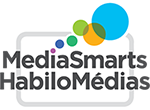Sharing Your Story Online
Here is a narrative description of the video, integrating the onscreen visuals with the narration, designed for a person who is blind or low-vision, following the best practices for post-production described video.
The video begins with text on screen that reads, “Sharing your story online.” The narration explains, “Here are some things to think about when deciding whether – and where – to publish something that you’ve made online.” Next, a person clutches a phone close to their chest, with the screen facing inward, symbolizing privacy. The narration continues, “You may not want to share what you’ve made at all! It could be that just making it is all you need.” Then, the person shows their tablet or a phone screen to two other people, who lean in and look intently at the screen. The narrator adds, “Or you could keep it on your device, and only show it to people you care about”. “If you do want to publish, here are some things you should think about.”
The word “Content” appears on screen. The scene shifts to an image of a person’s face on a phone screen. Behind them, a street sign is visible, and a circle appears around it, highlighting it. The narration asks, “How might what’s in it affect your privacy? Are there things like your face or your voice that would let people recognize you?” A person makes a funny face, sticking out their tongue, appearing to interact with someone off-screen. “If there are, how do you think you’ll feel about people seeing what you’ve made – now and in the future?” The view widens to include another person, who is making a funny face back in response. “Who else is identifiable in your story? How do you think they might feel about it?”
The word “Platform” appears on screen. The image from earlier, showing the two people making funny faces, is now displayed as a post on a mock social network or video site, resembling platforms like YouTube or TikTok. The narrator states, “Once you’re comfortable with some people seeing what you made, you need to decide where to publish it.” The narration continues, “Big platforms, custom sites or even a personal blog all have features that affect your privacy. Here are some points to think about”. A gear-shaped icon for a settings menu is highlighted and appears larger on the screen, and a pull-down menu then appears from it.
We see the Earth from space. The view then blurs and focuses on a half-dozen people’s faces, before tightly focusing on just one of the faces. The narration asks, “Can you control who sees what you publish? Can you make it so that just some people see it?” The mock social network post from earlier is shown again. The share and download icons located below the post are highlighted. The narrator explains, “How shareable will it be? There’s always some way to make a copy of anything online, but some platforms make it easier or harder to do.”
The account name, “Louise Roy,” is highlighted. The narrator asks, “Is your account tied to your real name or something else that identifies you?” The comment section below the post is highlighted. A gear icon appears in the top right corner, and the comment section greys out, indicating it can be disabled. The narrator asks, “Can people comment on what you publish? Can you turn that off if you want to?” A thumbnail of the social network post appears in a mock-up of the YouTube “Up Next” bar, suggesting related content. The narrator queries, “Could someone find what you’ve made in a search, or have it recommended to them by the platform’s algorithm?”
Finally, a phone’s home screen is displayed, featuring several different fake social network app icons. The narration concludes, “Finally, every platform has its own audience and culture: re-sharing or commenting may be considered normal on some but rude on others.” The video ends with the narrator stating, “Whatever your story is, it’s up to you whether – and how – to share it with the world.”
